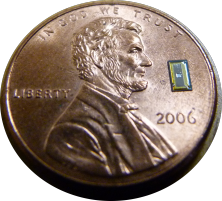Thin-film fabrication and advanced characterization vital to improving performance
In this research, CEA-Leti fabricated innovative thin-film batteries on the institute's TINY platform. Standard microfabrication techniques and a 200 mm wafer integration process flow were used to produce sub-square-millimeter microbatteries with a specific areal capacity five times that of today's commercially-available products. The batteries also exhibited exceptional power density and virtually no capacity fading over hundreds of cycles. These remarkable attributes are ideal for the longer battery life and small form factor needed for IoT devices.
Towards viable and more sustainable alternatives to lithium metal
Lithium metal, used in battery anodes, represents one of the major environmental hurdles to the adoption of the technology. Here, we focused on an anode-free model system utilizing a transition-metal dioxide (LiCoO2), an inorganic lithium phosphorus oxynitride (LiPON) glass electrolyte, and a titanium current collector. We were able to demonstrate full-stack cyclability, making this a viable alternative to lithium metal. In addition, the maximal discharge capacity was measured at 1.5 mAh.cm-2, unprecedented for thin film batteries. Plus, when this anode-free model was coupled with a 100% active cathode, the battery demonstrated a volumetric capacity of up to 1,400 Wh/l. We also investigated different cathode thicknesses: There was a linear correlation between thickness and delivered capacity for high current densities of up to 2 mA/cm². Diffusion limitations only emerged when the state of charge (SOC) fell below 50%, with thicker electrode designs proving advantageous as long as the battery charge remains above this threshold. Overall, this model appears to be very promising for a wide variety of on-chip energy storage needs.
Modeling the future of microbatteries
A comprehensive physical model, which aligns closely with our experimental results, was developed based on this research. It also factors in performance variations depending on design and architecture, making it a useful and relevant tool for the optimization of microbatteries for a variety of use cases, including medical devices.
